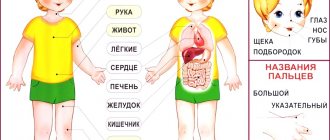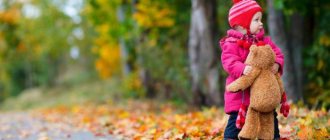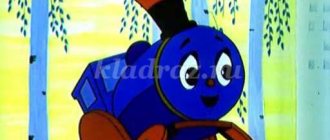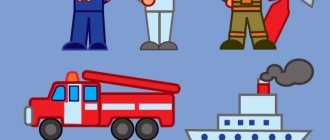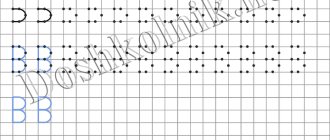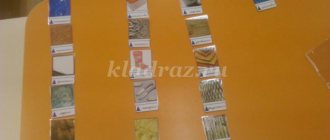Lesson summary for the preparatory group “Me and my body”
Lesson summary: “I am a person - my body.”
preparatory group
The lesson was conducted by the teacher: Lykova Elena Leonidovna.
Target
: To develop in children the ability to use knowledge about a healthy lifestyle for their own health, to develop their own version of a healthy lifestyle. To consolidate children’s understanding of the structure of their own body, to expand preschoolers’ knowledge about proper nutrition, its importance, and the relationship between health and nutrition. Cultivate the desire to be beautiful and healthy.
Tasks:
Physical education
:
- To form and consolidate skills in health-saving technologies that promote a conscious attitude towards one’s own health.
- Develop healthy lifestyle skills.
- Develop the ability to apply knowledge about a healthy lifestyle in practice.
Social and communicative development
:
- To develop in children conscious feelings towards their health;
- Develop interest in joint activities with peers and adults, the ability to work in a team, initiate communication and joint activities, politely respond to offers of communication, and joint games.
- Cultivate a positive attitude towards maintaining and strengthening your own health.
Speech development
:
- Enrich and activate children's vocabulary on the topic of the lesson. Introduce the following concepts into children's active vocabulary: heart, lungs, vitamins.
- Develop coherent speech skills;
- Strengthen children's ability to answer questions with complete answers. Express your opinion and actively participate in the discussion.
- Develop the ability to express value judgments about facts and phenomena that worsen or improve human health.
- To improve children's ability to use complex and complex sentences in speech.
Cognitive development
:
- Continue to introduce children to the concept of a “healthy lifestyle.”
- Summarize children’s basic knowledge about the work of various human organs and their names.
- Develop the ability to examine samples, diagrams, and establish relationships with practical purposes.
- Strengthen children's understanding of the structure of their own body.
- Expand preschoolers' knowledge about proper nutrition.
- To consolidate children's understanding of the structure of their own body, to give knowledge about the internal organs of a person and their purpose.
- Expand preschoolers’ knowledge about proper nutrition, its importance, and the relationship between health and nutrition. Cultivate the desire to be beautiful and healthy.
Equipment and materials:
diagram of the structure of the human body with internal organs, diagram of the human body with a labyrinth for each child, pictures of products containing vitamins A, B, C, D.
Technologies used and means of implementing tasks.
—
Health-saving technologies;
— Interactive technologies.
Preliminary work with parents and children:
- With parents:
-Invite parents, together with their children, to study additional literature about the structure of the human body and the functions of the organs of the human body.
- With kids:
— Review of encyclopedias about the structure of the human body; conversations about a healthy lifestyle and its attributes.
Goals:
Continue to teach children to take care of themselves and their bodies, to treat their bodies with care.
Continue to promote your health and instill hygiene skills.
Develop memory, thinking, imagination, activate vocabulary.
Equipment:
a poster with a picture of the human body and internal organs, pencils, human silhouettes, a tape recorder with recordings of calm music, a toy bird-sparrow.
Previous work:
reading books, looking at a poster with a picture of a person, puzzles “Assemble a person from parts.”
PROGRESS OF THE CLASS
1. Organizational moment
Educator:
Children, let's stand in a circle, hold hands, look into each other's eyes and smile, and say our names affectionately.
2. Game moment
The Storyteller comes in, carrying a large mirror in her hands.
- Hello guys! I am very glad to be visiting you again. And with me is my beautiful, magical mirror. Let's go to the magic mirror and, as before, we will find ourselves in a fairy tale. But first, solve the riddles.
Puzzles:
“He’s smarter than everyone else on earth because he’s stronger than everyone else.” (Human)
“They’ve been racing all their lives, they can’t overtake each other.”
(Legs)
- The five brothers are inseparable, they are never bored together.
They work with a pen, a saw, a spoon, and an ax. (Fingers)
Here is a mountain, and the mountain has two deep holes, in these holes the air wanders, then comes in, then comes out
(Nose)
- Day and night it knocks, as if wound up.
It would be bad if this knocking suddenly stopped. (Heart)
3. Storyteller:
“Well done guys,” and now let’s sit on our carpet and... One day, in good and calm weather, Chick sat on a birch branch and watched his friends in kindergarten. He looked from above and didn’t understand how they move if they don’t have wings, how they eat, if they don’t have a beak, why do people need arms and legs? And then he decided to fly to visit the children and ask how a person works.
Storyteller:
Chick came with me today. Guys, let's tell Chick how we work.
Children:
Let's.
Storyteller:
- Why do people need hands? (Children's answers: draw, sculpt, iron, etc.)
– Do you need to take care of your hands, and how?
(Children's answers: wash, wear gloves, do not take sharp or piercing objects) -
Why do people need legs?
(Children's answers: walk, run, jump)
- Do you need to take care of your legs, and how?
(Children's answers: wash, put on warm socks, wear comfortable shoes and the right size) -
Why does a person need a head?
(Children's answers: look, think, talk)
- How do we take care of our heads?
(Children's answers: wash, put on hats, protect your head from physical and solar blows)
- What does the torso consist of?
(Children's answers)
The teacher calls the child and shows him: here is the chest, back, stomach.
4. Working with cards with body parts drawn on them
– We need all parts of the body: with the help of our hands we eat, we draw. We do different jobs, with the help of our legs we can move, we need a head to think, on our face we have eyes to see, ears to hear, a nose to breathe and smell. And we need the torso, since there are organs inside it: heart, lungs, stomach (shows on the table)
. You see how many organs are inside a person and each one does its job: the heart, like a pump, sends blood to all parts of the body, food is processed in the stomach, we breathe with the lungs. A science called anatomy will help us learn about how we are structured inside and why all our organs are needed.
5. Chick does a physical exercise:
One - bend over, straighten up, Two - bend down, stretch out, Three - three claps on your hands, three nods with your head, Four - arms wider, Five, six - sit down quietly.
6. The Storyteller and Chick invite the children to stand in a circle and conduct simple experiments:
Educator:
Place your hands on your left side and listen to your heart beat.
Children:
Quiet
Storyteller:
What if you give your heart physical activity?
Storyteller:
Sit down three times, jump three times, listen to your heart? How does it beat?
Children:
And now stronger.
Storyteller:
And a person also has the main internal organ with which we breathe, these are the lungs.
Storyteller:
place your hand on your chest and stomach and inhale. When you inhale, the chest expands, and when you exhale, it contracts.
Children take balloons and inflate them, thereby seeing how the lungs work.
Storyteller:
A person also has a stomach that takes food and processes it.
And our cells receive the energy necessary for human life. Let's do another experiment. Take a glass of water and drink the water in small sips. How do we feel? Where did the water go? Children point to their stomach
.
Storyteller:
That's right, children, water and food enter the stomach, where it is digested. Chick, now do you understand how a person works? And what does a person need legs and arms for?
7. Productive activity.
Storyteller:
Now let us draw you the internal organs of a person and show you how the heart beats, how we breathe, where food goes. You also have all these organs, Chick, but they are much smaller than in humans.
Children take the silhouettes of a person and begin to draw on the body the internal organs they have become familiar with (calm music plays).
8. Lesson summary:
Exhibition and viewing of drawings with a diagram of a person and internal organs.
Educator:
What new children did you learn in class about the internal organs of humans?
(Children's answers).
LiveInternetLiveInternet
Tuesday, September 24, 2013 23:12 + in quote book Lesson notes “Parts of the body” Lesson “Parts of the body” Objectives: to introduce children to the parts of the human body; teach how to form plural nouns; learn to compose sentences using visual material; teach to distinguish between the right and left hand, leg, etc.; consolidate the dictionary on this topic; develop attention. Equipment: demonstration material - pictures of people, toiletries; handout - envelopes for each child with geometric shapes. Progress of the lesson. 1. Organizational moment. The teacher displays a series of pictures: girl, boy, man, woman, grandmother, grandfather. Children remember the sequence and pronounce it (the sequence of pictures changes several times). -What is the name of what is drawn in these pictures in one word? (People, person.) -Who do you think we will talk about? (About a person, about yourself.) The teacher shows a drawing of a person. — What is the name of the largest part of the human body? (Torso) The teacher shows where the chest, stomach, back are, then asks riddles: 1. For the animal - on the top of the head, and for us - below the eyes. (Ears) . What are ears for? 2. Two Yegorkas live near the hill. They live together. And they don’t pet each other. (Eyes) . 3. He can be very different: Kind, harmful, Proud, important, Long, small, hunchbacked, Long, small, hunchbacked, Thick, thin, freckled. (Nose) . -What is the nose for? A person also has a forehead, cheeks, eyebrows, eyelashes, nostrils, lips, and chin. (Children show the named parts of their faces). 2. Didactic game “One - many”. Ear -ears, neck-, eye-, hair, head, face-, nose-, mouth-... 3. Physical education minute. Girls and boys Children jump on the spot, Jumping like balls. They stomp their feet, they clap their hands. They clap, nod their heads, and quietly curtsy. squat slowly. — Guys, what were you clapping for just now? (Hands). -Show your right hand, your left. The teacher names the parts of the hand, and the children point to themselves (fingers, nails, palm, elbow, shoulder). -What did you stomp on? (with legs) 4. Similar work is being carried out. 4. Didactic game “Choose the words.” The teacher asks the children questions one by one: “What kind of eyes do you have?” (My eyes are beautiful, gray, large, etc.) - What kind of hair do you have? (My hair is thick, long, shiny, etc.) - What are your nose, mouth, ears like? (Similar work is being carried out). 5. Reading and discussion of an excerpt from K. I. Chukovsky’s poem “Moidodyr”. Oh, you ugly, oh, you dirty, unwashed pig! You are blacker than a chimney sweep, admire yourself. There's polish on your neck, There's a blot under your nose, You've got such hands that even your trousers have come off, Even your trousers, even your trousers. They ran away from you. — Guys, who do you think these poems are about? (About a slob, a dirty person.) - What should you do to be clean? (Wash your face, wash your hands, body, etc.) -Show me how to do it. Children stand one after another and imitate movements, showing how they wash themselves, wash their hands, feet and other parts of the body. -A person must be neat and clean. It is always a pleasure to communicate with such a person. To do this, you need to wash your hands, comb your hair, clean and iron your clothes, and clean your shoes every day. 6. Didactic game “What things does a person need to be clean and tidy?” Various objects are laid out on the table: toothbrush, soap, iron, washcloth, etc. Children choose any object and make up sentences. For example: A person needs a comb to comb his hair, etc. 7. Educational task - create a human figure. 8. Summary of the lesson. Children name the main parts of the human body in a “chain”.
| Categories: | Teaching is not a job, but a way of life
|
Tags:
Lesson notes “Parts of the body”
Cited 1 time
Like share
0
Like
- I liked the post
- Quoted
- 0
Saved
- Add to quote book
- 0
Save to links
Liked
0
